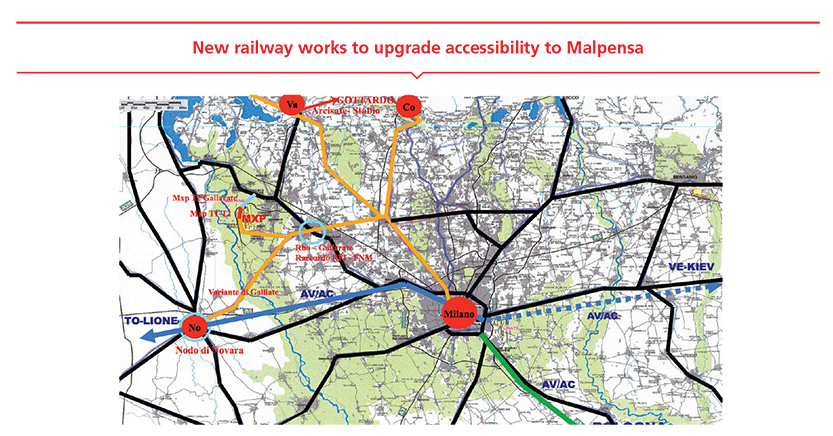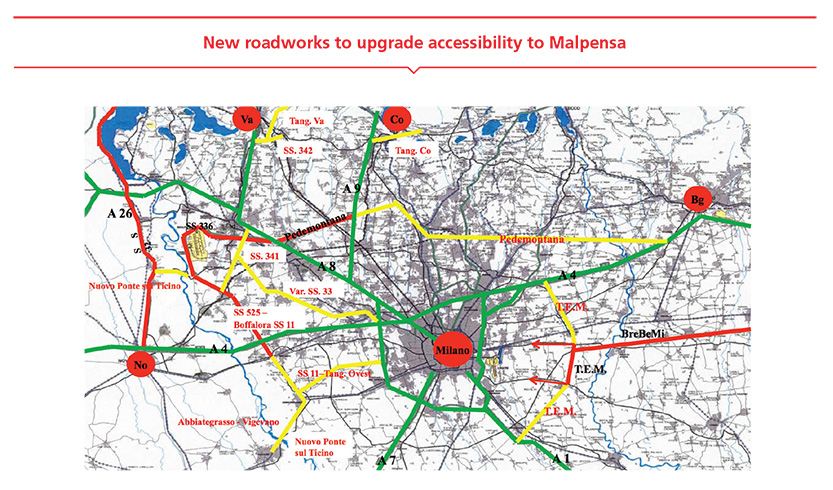Current and prospective accessibility to airports1
From an airport point of view, i.e. from the point of view of service to the demand of transportation generated within the airport relevant area, the scale of priority in terms of land accessibility to the airport is:
- links to the key city with the highest concentration of transport demand (in this case Milan City);
- links to the metropolitan area gravitating around the key city or anyway in the "narrow" catchment area (around the 60-minute isochron from the airport). As far as Malpensa is concerned, this area corresponds to Milan hinterland, the most urbanized parts of the foothill strip (from the provinces of Varese to Bergamo), the eastern provinces of Piedmont (Verbano-Cusio-Ossola, Novara, Vercelli) and the Canton Ticino;
- links to other large and medium-sized cities located at greater distances but served by means of transport (particularly High Speed Rail) that guarantee travel times of less than two hours. In case of Malpensa, this includes first of all Turin and Lower Piedmont (Alessandria, Asti) and then Genoa, Emilia (from Piacenza to Bologna), Florence, East Lombardy (Brescia) and Western Veneto (Verona).
Current rail accessibility to Malpensa Airport
Regarding quantity and quality of rail links, the throughput of Trenord in the offer of the connection service between Milan City and Malpensa airport is definitely significant. In overall terms, there are 129 daily journeys that give rise to an average hourly rate during the 20 operating hours of one journey every 18-19 minutes per direction. The minimum travel time (29') is absolutely adequate and competitive with international standards (the centre of Munich is connected to the airport with two different services, 43' and 53 'respectively). All journeys are entirely made by rolling stock specifically designed for airport service, of recent construction, with good performance and good comfort levels.
In 2016, the railway line joining Malpensa's Terminal 1 and 2 was inaugurated, which will help avoid the inconvenience of transferring between the two terminals by shuttle bus. In addition, quick and frequent connections between the two terminals enable a more efficient supply of Terminal 1 (dedicated to mid-long-haul flights) by Terminal 2 (characterized by short-medium-haul flights).
The cost of this operation was 115 million Euro, 23 million of which came from the European Union, 16 million from SEA, 45 million from the State and 31 million from the Lombardy Region.
Future rail accessibility to Malpensa Airport
Upgrading of Novara-Malpensa segment
A link is essential to connect Turin-Milan high-capacity line with Malpensa airport. The operation concerns the upgrading of the Ferrovie Nord Milano (FNM - North Milan Railways) segment from Novara to Busto Arsizio, where it connects with the Novara-Malpensa line already in operation. At the same time, the functional integration of the line with the Novara HS/HC (High Speed/High Capacity) station on the Turin-Milan is planned. Magnago-Vanzaghello's doubling has been active since 2008, while in December 2014 the Castano Primo-Turbigo route was also activated. The Galliate variant requires a separate discussion. The design also includes a link between the historic line and the HS/HC Milan-Turin line, enabling the activation of a direct service between Turin and Malpensa using the HS/LC (High Speed/High Capacity) network. The preliminary project is still pending at the CIPE (Interministerial Committee for Economic Planning) for lack of funding needed for its implementation, amounting to 87 million Euro. However, the urgent need to re-modernize three bridges along the Langosco stream has made it necessary to carry out a functional fragmentation of the works funded with 6 million Euro from the Lombardy Region. The works were started in November 2016 and are scheduled to be completed by the beginning of 2018.
Novara hub
The project needed for the new rail system of the Novara hub involves building a direct connection between HS/HC line from Turin and Ferrovie Nord Milano towards Malpensa, exploiting the aforesaid interconnection of Novara West, and building Galliate railway variant and other infrastructure upgrades on FNM line. There have been no significant advances in 2016 regarding the approval of the feasibility study on Novara hub. The 2012-2016 RFI (Italian Rail Network) ERA (Economic Regulation Agreement) - 2016 update, confirms the expected allocation of 81 million on Novara hub, in addition to the 9 million allocated by the RFI ERA - 2015 update.
Rho-Gallarate rail link upgrade and Y connection for direct connection between Rho-Fiera/Expo and Malpensa
The project includes the creation of a quadrupling segment, alongside the two existing ones, along the railway segment between Rho and Parabiago, with a continuation that includes the construction of a third track between the stations of Parabiago and Gallarate. The upgrade of the above route allows for an increase in available capacity to meet the mobility requirements of the route, as part of the broader infrastructure context of the south access to Malpensa Airport. The overall project involves the construction of a single-track at-grade link connecting RFI line Rho-Arona (at Legnano) to Saronno-Malpensa FNM line (at Busto Arsizio). As far as Rho-Parabiago section is concerned, the Final Project is being supplemented on the basis of the Observations of the Higher Council of Public Works in order to continue the approval process with the Ministry of Infrastructure and Transport. Both the Rho-Parabiago segment, costing 402 million Euro, and the Parabiago-Gallarate segment, costing 321 million Euro, are currently not covered under the 2016 Update of the Economic Regulation Agreement.
North link from Malpensa with the railway lines to the Sempione and the Gotthard
The project consists of a double-track link to Malpensa Terminal 2 and the existing line of Sempione via two connections, towards Gallarate (Milan direction) and towards Domodossola (Sempione direction). This long-term project will meet the strategic goal of networking Malpensa Airport with the local territory through the Sempione and Gotthard routes, significantly increasing the catchment area. The technical and economic feasibility project was concluded in November 2016 and was delivered to the Lombardy Region. The cost of the operation is 180 million Euro, yet to be raised.
Arcisate-Stabio railway
The project involves the construction of a new railway line between Mendrisio and Varese linking the historic Gotthard line, via Milan-Varese line, to Malpensa Airport (via the X-link at Busto Arsizio and a new segment north of Gallarate, for which there is only one feasibility study). The operation will make it possible to reach the airport in 50 minutes from Lugano and 70 minutes from Bellinzona. The project involves the construction of a new dual-track line that connects the existing Stabio track with Varese-Porto Ceresio line at Arcisate. The new connection is approximately 8 km long, of which 5.7 km are newly built.
On January 4, 2016, the CIPE resolution approving the new project for the works was published in the Official Journal, with the new spending limit rising from 223 to 261 million Euro. The project includes excavations containing naturally-occurring arsenic in the former Femar quarry. The civil works are under way, and the construction of the rail tracks, electric traction, and safety and signalling systems are scheduled for 2017, with the launch of the new line scheduled for December 2017.

Road accessibility to Malpensa Airport
Roads are currently the most important link system to Malpensa Airport. Private vehicles can rely on two existing motorways (A8 and A4 connected via Malpensa-Boffalora motorway link) and one under construction (Pedemontana). Private vehicles also include hotel shuttles and tourist buses. The road system is also used by a variety of collective and individual public transport: airport bus, taxi, limo and car sharing (e-Vai). Over the next few years, large-scale infrastructure investments are planned on Lombardy road network. These should have a positive impact on the quality of links to Milan's airports, both in terms of travel time and ease of access.
Magenta-Abbiategrasso-Vigevano-Milan West Ring Road
The operation is a continuation of Malpensa-Boffalora/A4 motorway and, as part of the links to Malpensa, it provides a roadway outside Milan West Ring Road, aimed at facilitating the connections between Milan, the west of Milan and A4 at Malpensa-Boffalora motorway. At the beginning of 2016, based on discussions between ANAS, Milan Metropolitan City, local authorities and the Ministry of Infrastructure and Transport, it was decided to proceed with the approval process of Abbiategrasso (Vigevano-Abbiategrasso-Milan West Ring Road) and carry out specific works on the Abbiategrasso-Magenta segment. However, even as a result of the lack of agreement between all the parties involved, at the end of the year no progress had been made on the works approval process, and this should lead to the convening a new local authorities planning conference for the project's approval. The operation is funded under the ANAS Economic Regulation Agreement for 220 million Euro.
SS341 Vanzaghello-Samarate variant
The 9.4 km operation aims to connect the Malpensa-Boffalora, at Vanzaghello, and A8 motorway, through the new Gallarate road link. The works will reach the Pedemontana Lombarda, in order to make a quick link between the north of Lombardy with A4 (Turin direction) and Milan (SS11 and West Ring Road). Works cost 261.78 million Euro, of which 133.02 million Euro are available, which make it is possible to achieve a functional segment consisting of the section between the SS 336 and A8 motorway (Bretella di Gallarate), indispensable to ensuring transport continuity of vehicle flows from Pedemontana Lombarda towards Malpensa and vice versa. The final project is pending with the Ministry of Infrastructure and Transport for the CIPE approval.
SS33 variant of the Sempione Rho-Gallarate
Sempione variant, known as "Sempione bis", consists of a single roadway of about 30 km with one lane in each direction of travel. The proposed route splits off from the current SS33 at Rho, at the intersection with the Milan West Ring Road, and crosses the municipalities of Pogliano Milanese, Vanzago, Nerviano, Parabiago, Canegrate, Busto Garolfo, Dairago, Villa Cortese and Busto Arsizio, ending at Samarate, where it intersects with another infrastructure being designed, variant of the SS341, creating a link with the A8 motorway.
The cost of the works is 420 million Euro, of which 42.27 million are funded. The preliminary project of a functional segment, to be started with the available funding, is still pending at the Ministry of Infrastructure and Transport for CIPE approval.

Milan-Turin motorway
The works consist of widening the motorway sections and building a 3-metre emergency lane. The current 10-metre roadways in each direction of travel (3 lanes, each 3.33 metres wide), with a 4-metre centre divider, will reach a total of 24 metres overall, with two 14.25-metre roadways. The adaptation and upgrading is necessary in view of the construction of the Marcallo-Mesero (Boffalora)-Malpensa link (performed by ANAS), which has led to a significant increase in traffic along the A4 along the segment in question.
Current and future accessibility to Linate Airport
Metro system Line 4 Lorenteggio-Linate
The project involves the construction of a completely automated metro line (without driver) connecting along 14.2 km Linate airport with FS San Cristoforo railway station (on Milan-Mortara railway line), with a total of 21 stops. The total cost of the works is 1.8 billion Euro, of which 958 million Euro are funded by the State, 461 by private entities and 400 by the Municipality of Milan.
The works continued over the course of 2016, also involving the central segment between Piazza San Babila and San Vittore. Tunnel excavation and station construction will continue between 2017 and 2019, while plants will be built between 2020 and 2022, when operation is expected to open.
1Source: North-west OTI, 2016 Report